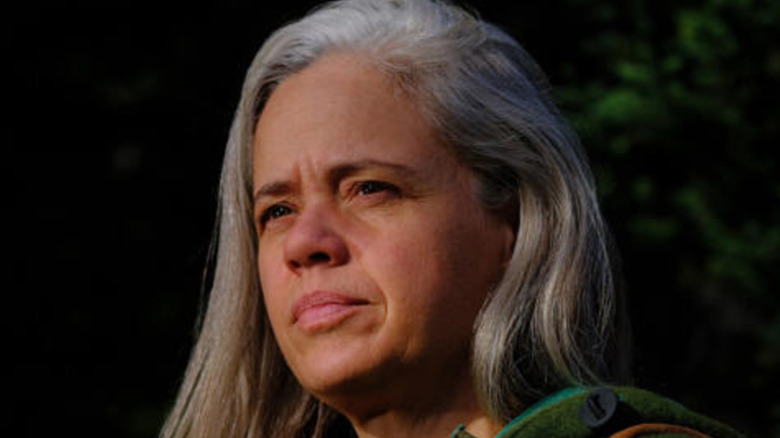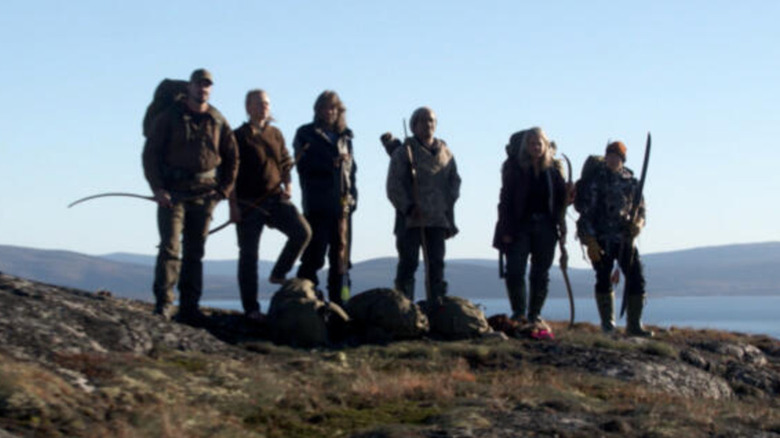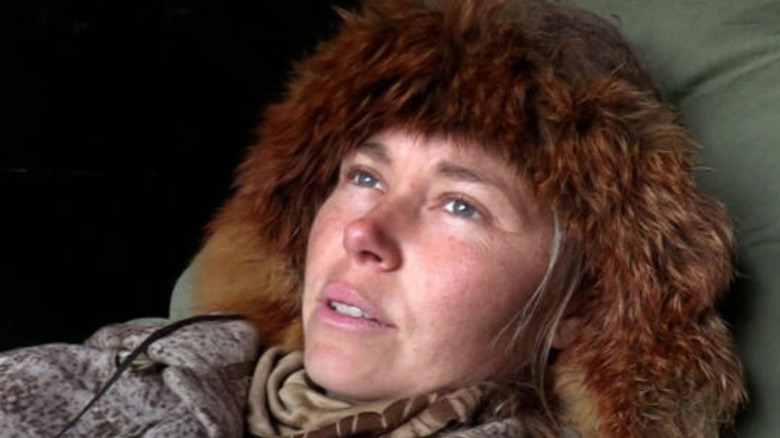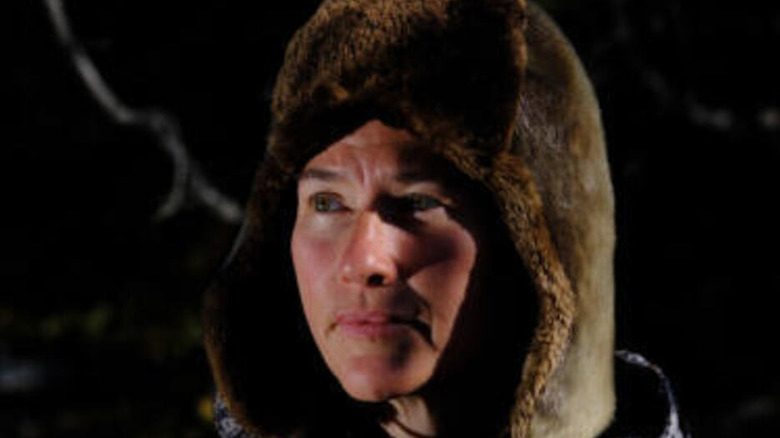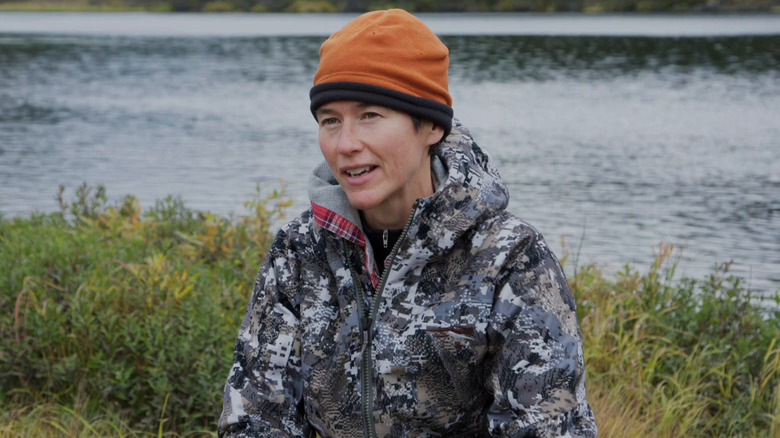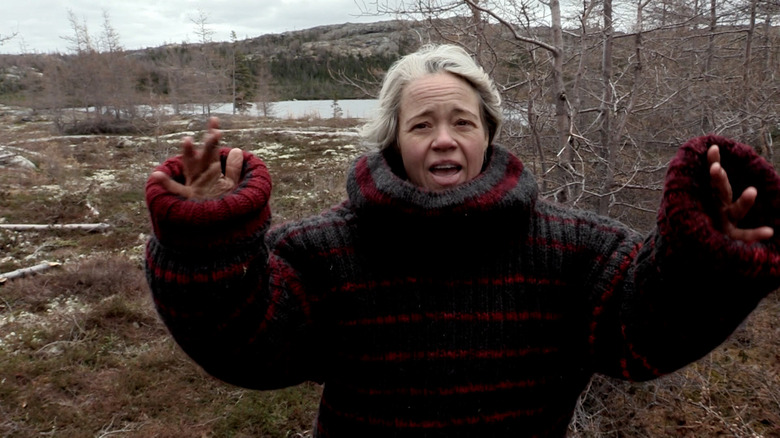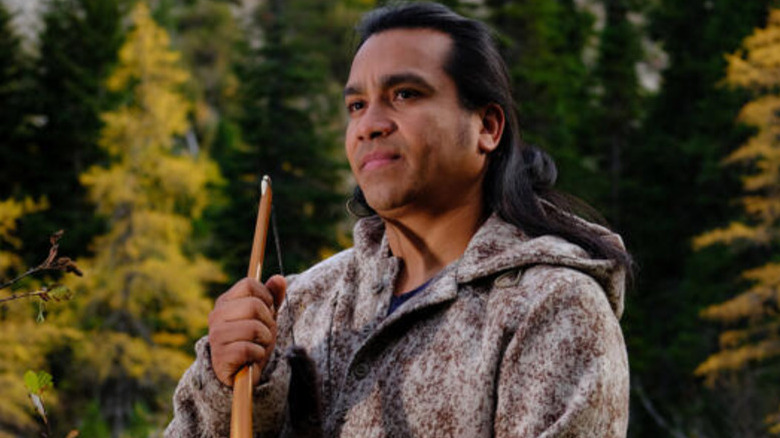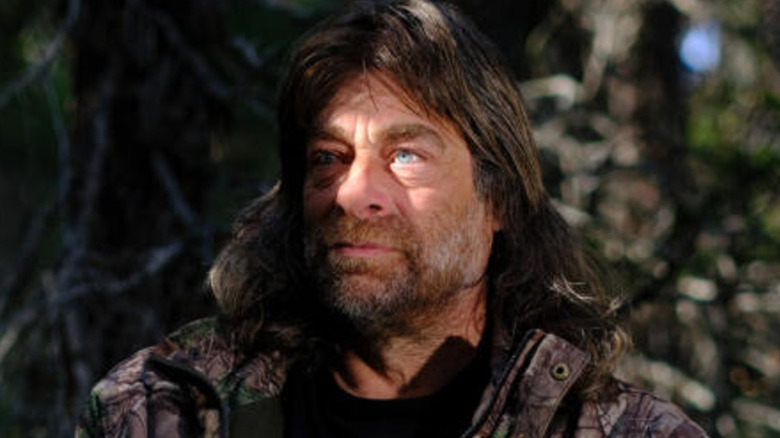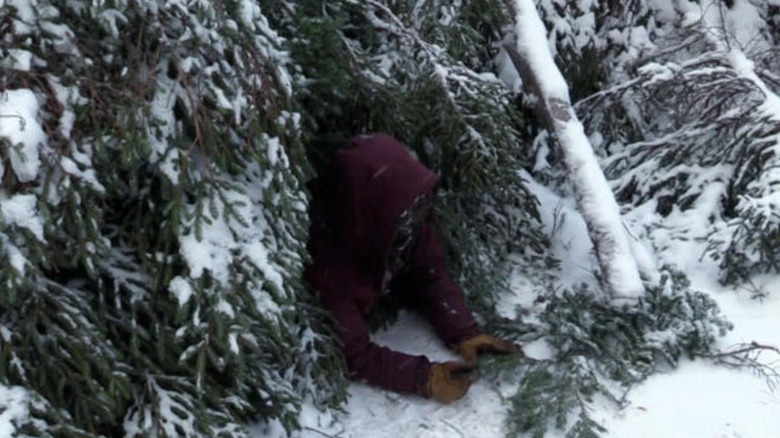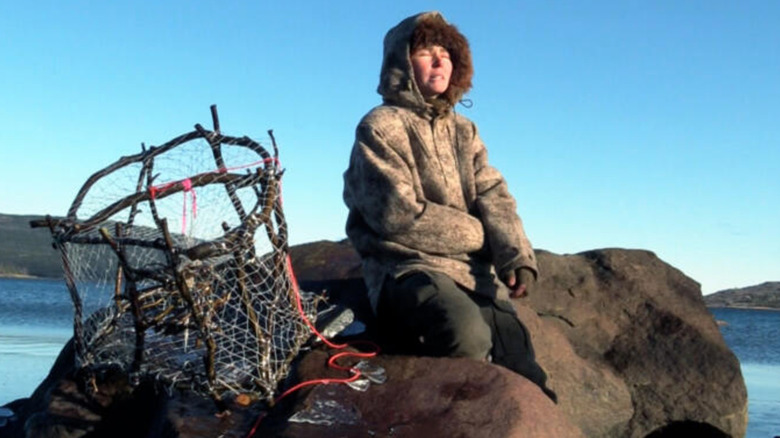Alone: Frozen Facts To Know So You're Not Left Out In The Cold
On the back of the successful reality survival show "Alone," the creators have launched the spinoff series "Alone: Frozen." Before you get the wrong idea, this isn't something nice and light, like the Disney-animated musical hijinks we've all come to associate with the word "Frozen." This show follows six past contestants of "Alone" as they're dropped into northern Labrador in eastern Canada for 50 days during the depths of winter. Our brave cast is as follows: Greg Ovens (Season 3), Woniya Thibeault (Season 6), Callie Russell (Season 7), Mark D'Ambrosio (Season 7), Amós Rodriguez (Season 7), and Michelle Finn (Season 8).
Since the beginning of "Alone," viewers have been shown contestants battling the worst challenges, many resulting in lasting health issues and even PTSD. Just when you think it can't get any worse, the intro proclaims that this version of the show is "The most difficult and dangerous survival experience ever attempted." As with any reality TV series, what we see onscreen is not always necessarily the full story, so let's dig down into the truth of "Alone: Frozen," exploring the perspectives of some of the contestants in their own words. Spoilers ahead if you've yet to delve in.
The first winner to make history
The eventual winner of "Alone: Frozen," 47 year-old Woniya Thibeault, marked a first for the whole "Alone" franchise — the first woman to win. This show was previously heavily dominated by men, highlighting the way that survival skills are often thought of in terms of men and not women. Thibeault's victory was a long time coming, with the original "Alone" show already up to nine seasons with no women coming out on top.
In a Q&A with Outside Online, Thibeault responded to this, saying, "I'm not just the first woman to have won 'Alone,' I'm also now the person who has had the most cumulative days spent in the wilderness in the show's history. I think that the world has, for a long time, seen survival skills as more as being for men, even though all of us had ancestors — men, women, children, elders — who used to live in the wild." She also pointed out proudly that the final three contestants on this show were all women, and she was extremely glad to represent that.
You can check out Woniya Thibeault on Instagram at @buckskin_revolution, where she promotes her time on "Alone: Frozen" along with her other ventures, including online classes and events. As per the Buckskin Revolution website, her mission is to "help people feel connected to their wildest, freest selves, to their human community, and to the living world around them."
The truth of returning
With this show being a spinoff of the original, and the concept requiring experienced contestants, the creators decided to bring back previous participants ranging from Season 3 all the way to Season 8 — a unique development for the "Alone" franchise. The first time around, the competitors were unaware of exactly what they were getting themselves into; this time, they'd already done it once — and they still agreed to come back. This has been a recurring theme in recent years, with numerous reality television series bringing back contestants for a second chance or redemption. We see this with other shows such as "RuPaul's Drag Race" and "America's Next Top Model," but "Alone: Frozen," as an extreme survival show, is on another level entirely.
Winner Thibeault heavily documented her experiences surrounding "Alone: Frozen," and in a YouTube video introducing the show, she explains, "You don't understand the long-term consequences to your body when you go out the first time." Ahead of their brave returns, our contestants have a deeper understanding. Thibeault also recorded episode-by-episode reviews, and in her Episode 1 video, she commented that "PTSD comes up for you ... you go out again and your body and your nervous system are saying what are you doing to us? Your body remembers it as traumatic." This uncovers a side of this show that viewers may not immediately consider — namely, how taxing it will become for these survivalists. Does it go beyond what could be considered moral entertainment?
Was Michelle Finn ready?
Michelle Finn had only just competed in a regular season of "Alone" one year prior to appearing on "Alone: Frozen," and viewers worried that she hadn't had enough time to recover. In an interview with Entertainment Weekly following her appearance on "Alone," Finn commented, "I got beat to hell out there. I was pretty ravaged; my whole body was covered in bruises. I lost 22 pounds from my already tiny body. I was having physical symptoms that were sketchy. My blood wasn't clotting; I was blacking out more and more frequently for longer and longer periods. I was having chest pains. So yeah, I felt like I might've been able to squeak out a few more days but at what cost?"
Woniya Thibeault also mentioned this in her video about "Alone: Frozen," referring to her recovery time after her first season. She emphasized how she could have kept going further, but it would take "the next year plus ... in my case, a good year and a half to two years to actually recover from this experience."
Despite the physical and mental effects she suffered from her stint in Season 8 of "Alone," Finn was still more than happy to jump straight into the icy cold spinoff. It just goes to show how far these passionate individuals will push themselves, and how up for a challenge they are.
Rose-tinted glasses
For many viewers, Michelle Finn's decision to return for "Alone: Frozen" was as difficult to understand as it was easy to admire. It's worth considering, however, that returning contestants may see this potentially dangerous opportunity through rose-tinted glasses. Like anything that has a profound impact on us in some way, our memories of such an event can become skewed. Thibeault discussed this in a YouTube video, explaining, "I think it's similar to childbirth ... where you forget some of the really hard parts and just remember all of the love and the glory ... that is definitely true of 'Alone' too."
In addition to the haze of memory, their willingness to return may also come from an increased confidence; Thibeault has explained how she felt she had more "experience, plus a lot more studying and learning." It might just be that these natural survivors and thrill-seekers will jump in no questions asked. After all, it is quite common for people to keep having babies despite the risks that come along with it. Everybody's different.
The effects of COVID
Some of this seems like a distant memory now, what with many COVID restrictions now being eased or lifted entirely, but anyone who had to travel during the pandemic will know how difficult it was. It was a time when we had to put our health and safety above all else, and the entertainment industry was no different; COVID had an understandably profound impact on the production of TV shows and films. Many had to pause their shoots, postponing or ultimately canceling altogether. On the set of "Alone: Frozen," filming went ahead, but contestants had to have negative COVID test results within a very small window of their flights.
Thibeault recounted her chaotic experience in her YouTube video about traveling for the show. When her test results failed to come through, she was not allowed to catch her first flight. During her next attempt, a flight with fellow contestant Callie Russell, she was stopped from boarding because it was full. After a few more complications, she managed to arrive only a day later than the others. Luckily, she only had to take one extra COVID test to ensure she was still negative.
Mark and Amos, dedicated fathers
From the beginning of the show, one of the most important things for contestants of "Alone" has been their connection to the outside world. For many, this is partners, children, family, friends, and pets. When you put yourself in their shoes, would you want to leave someone you love for so long with no contact? It's beyond brave. For "Alone: Frozen" competitors Mark and Amos, joining the show meant leaving their very young children behind. As new fathers, they had to make the very difficult choice to enter the competition or remain at home.
Before the official launch, they were able to talk with their children on Zoom and have some last-minute bonding before the challenge began. In Thibeault's episode one recap, she mentioned that "I know what a big deal it was for both of those guys to be away from their young children." Mark, particularly, was vocal about his reservations in regard to going out for a second time. Ultimately, it became the reason that Mark tapped out in Episode 1, as Thibeault explained. Going on "Alone: Frozen" is a brave mission, but there is perhaps something braver about leaving to be a dedicated parent.
Watching themselves on TV
What must be an extremely strange experience is made even stranger for contestants when they take the opportunity to watch themselves on TV as episodes of "Alone: Frozen" air on the History Channel. Contestants have said that watching themselves on the show was a big challenge, because they were able to compare their locations and tactics with those of the other players.
In her YouTube series, winner Woniya Thibeault also admitted that watching herself on TV was worrying and stressful, saying, "[You're] watching yourself not knowing what they're going to show and what they're not going to show, not knowing the things that were really important to you were going to be cut out." As many reality television fans now realize, the producers of these series can choose what to show and what not to show. It also leaves room for potential regret in the contestants as they compare themselves to each other. We have to wonder whether any of them refrained from watching the show for these very reasons.
Extreme weather conditions
As the title of the series suggests, the most unique element in "Alone: Frozen" is the weather. For this spinoff, contestants were dropped in northern Labrador in eastern Canada just as winter was hitting its peak. This meant a number of extreme weather conditions — chiefly that it was considerably colder than these contestants (not to mention most people on Earth) were used to.
In Thibeault's YouTube recap series, she talked about the weather, and what posed the biggest challenge for her. She emphasized that wind remains the most difficult challenge to navigate, as it makes even the smallest of tasks much more difficult. This video, a recap of Episode 6, also marked when the snow first arrived for our brave group of survivalists. As viewers, we would probably assume the worst if we were stuck in the middle of nowhere in the freezing cold snow. However, Thibeault claimed that while it did make survival more "challenging," it was also surprisingly a huge benefit when it came to hunting animals, as the contestants were able to see the "movements" of their prey.
Is it all real?
As with any reality television show, "Alone: Frozen" viewers are left wondering whether everything they see onscreen over the course of the series is entirely real. Some moments seem staged, scripted or over-produced, but with the "Alone" franchise, there appears to be a strong consensus that it's indeed real. In an exclusive article, Distractify spoke to "Alone" executive producer Ryan Pender about the legitimacy of the long-running show. Pender confirmed that the contestants are "truly alone," and while members of the crew do remain close by, it would still take them between half an hour to an hour to reach contestants in the event of an emergency.
Additionally, in a 2018 Cynopsis interview with "Alone" executive producer Shawn Witt, he refuted claims that any of the seasons are staged and assured viewers that what they see is authentic. "We pride ourselves," he explained, "in providing each participant with the most unobstructed opportunity to test their survival skills, isolated, in a wild environment — while also taking the necessary safety precautions." We can assume the same is true regarding the show's icy spinoff.
